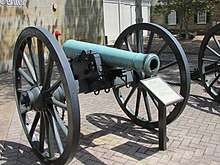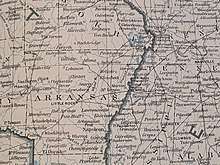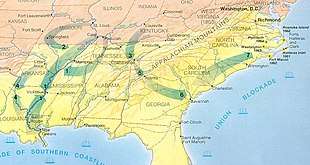1st Missouri Field Battery
The 1st Missouri Field Battery was a field artillery battery that served in the Confederate States Army during the American Civil War. As the Confederates had lost control of the state of Missouri after the Battle of Pea Ridge in early 1862, the battery was formed by Captain Westley F. Roberts in Arkansas in September as Roberts' Missouri Battery. The unit then fought in the Battle of Prairie Grove on December 7, as part of a Confederate offensive. Roberts' Battery withdrew after the battle and transferred to Little Rock, Arkansas, where Roberts resigned and was replaced by Lieutenant Samuel T. Ruffner. During the middle of the year, the unit, as Ruffner's Missouri Battery, was part of a force sent to the Mississippi River under the command of Colonel John Bullock Clark Jr., with the intent of harassing Union shipping. Clark's force was eventually recalled to Little Rock, which was being threatened the Union Army of Arkansas under Major General Frederick Steele. The Confederates abandoned Little Rock on September 10, and Ruffner's Battery saw action during the retreat as part of the rear guard.
| 1st Missouri Field Battery Roberts' Missouri Battery Ruffner's Missouri Battery | |
|---|---|
 A 6-pounder smoothbore gun of the type issued to the battery | |
| Active | c. September 7, 1862 to June 7, 1865 |
| Allegiance | |
| Branch | |
| Type | Artillery |
| Engagements | American Civil War |
After the retreat from Little Rock, Ruffner's Battery was temporarily assigned to Brigadier General John S. Marmaduke's cavalry division. The battery accompanied Marmaduke in a expedition against the Union garrison of Pine Bluff, Arkansas, seeing action at the Battle of Pine Bluff on October 25. The unit's assignment to Marmaduke's division ended in December, and it became part of Brigadier General Mosby M. Parsons' division in early 1864. Parsons' division was ordered into Louisiana in April to counter a Union thrust up the Red River. While Parsons' infantry was engaged at the Battle of Pleasant Hill on April 9, Ruffner's Battery served in a reserve role and was not engaged. The Union column engaged at Pleasant Hill continued to retreat back down the river, so Parsons was returned to Arkansas to move against Steele's Camden expedition. Supply issues forced Steele from a position at Camden, Arkansas, and the Union troops were pursued to the Saline River. On April 30, the Confederates caught up with Steele at the river crossing and attacked, starting the Battle of Jenkins' Ferry. Ruffner's Battery, along with Lesueur's Missouri Battery, supported an infantry assault, but moved to an exposed position in the process. A Union counterattack captured several of Ruffner's Battery's cannons. Steele escaped across the river that night. Ruffner's Battery spent the remainder of the war in Louisiana and Arkansas before being paroled on June 7, 1865, at Alexandria, Louisiana; General Edmund Kirby Smith had signed surrender terms for the Confederate Trans-Mississippi Department on June 2.
Background and formation
_(14761985221).jpg)
When the American Civil War began in early 1861, the state of Missouri did not secede despite being a slave state. The Governor of Missouri, Claiborne Fox Jackson, mobilized pro-secession state militia to encamp near St. Louis, where a federal arsenal was located. Brigadier General Nathaniel Lyon of the Union Army, commander of the arsenal, dispersed the militiamen on May 10 in the Camp Jackson affair. Lyon's action was followed by a pro-secession riot in St. Louis. In response, on May 12, Jackson formed the pro-secession Missouri State Guard, a militia unit, and appointed Major General[lower-alpha 1] Sterling Price as the its commander. On June 15, Lyon drove Jackson and the secessionists from the state capital of Jefferson City; Jackson then occupied Boonville. Two days later, the secessionists were forced out of the latter place, and Jackson and Price fell back to southwestern Missouri.[2]
Lyon pursued the Missouri State Guard, although a portion of his force commanded by Colonel Franz Sigel was defeated at the Battle of Carthage on July 5. After Carthage, Jackson temporarily left the state, and the anti-secession elements of the state legislature voted against secession.[1] In early August, Price and the Missouri State Guard were joined by Confederate States Army troops commanded by Brigadier General Ben McCulloch. On August 10, Lyon attacked the combined camp of Price and McCulloch. The Union plan at the Battle of Wilson's Creek involved a pincer attack in which Lyon hit the encampment from the front, and Sigel attacked from the rear. However, Sigel's force was routed and Lyon was killed, and the battle ended in a Union defeat.[3] Price and the Missouri State Guard then headed north towards the Missouri River in a campaign that culminated in the successful Siege of Lexington in September. In October, Union forces commanded by Major General John C. Frémont concentrated against Price, who retreated southwards to Neosho, where he was joined by Jackson. On November 3, Jackson and the pro-secession legislators voted to secede and join the Confederate States of America as a government-in-exile.[4]
In February 1862, pressure from Brigadier General Samuel R. Curtis' Army of the Southwest led Price to abandon Missouri for Arkansas. In March, Price, McCulloch, and Major General Earl Van Dorn joined forces to form the Army of the West.[5] Van Dorn moved against Curtis, and the two foes fought the Battle of Pea Ridge on March 7 and 8. McCulloch was killed and the Confederates and Missouri State Guardsmen were defeated. After Pea Ridge, the Army of the West retreated to Van Buren, Arkansas.[6] Eventually, many of the members of the Missouri State Guard transferred to official Confederate States Army formations.[7] Around September 7, while located at Van Buren, Captain Westley[lower-alpha 2] F. Roberts formed a field artillery battery that would bear his name. The battery was armed with cannons in October: two 12-pounder James rifles that had been taken from Union forces at the Battle of Lone Jack and two 6-pounder smoothbores.[9]
Service history
1862
On December 7, the battery was engaged during the Battle of Prairie Grove.[9] During the fight, Roberts' Battery was part of Colonel Robert G. Shaver's brigade, along with several infantry regiments from Arkansas.[8] Shaver's brigade was initially held in reserve, but it was ordered from the Confederate left to the right by army commander Major General Thomas C. Hindman. Roberts' Battery then moved forward onto a ridge.[10] The battery's new position gave it a clear field of fire against Brigadier General Francis J. Herron's Union division. Of the battery's four cannons, only the two James rifles could be deployed due the terrain,[9] although the two 6-pounders were still with the battery. The James rifles were the only rifled cannons available to the Confederates at Prairie Grove.[11] After deploying, Roberts' Battery came under heavy Union fire. In turn, the Missourians took up a new position further down the ridge.[9][12] Even in the new position, Union artillery fire was too heavy to render the battery's position tenable, and the guns were withdrawn back up the hill. Eventually, Roberts decided that the battery could not hold its position, and the gunners abandoned the pieces and took shelter in some nearby woods.[12] The battery had participated in the fighting at Prairie Grove for two hours, and damaged two cannons of Battery L, 1st Missouri Light Artillery;[9] one shot from the battery almost hit Herron.[13] The battle ended when night fell, and the Confederates retreated from the field. In order to mask the noises of retreat, the wheels of Roberts' Battery's cannons and caissons were padded with blankets. The retreat continued until the Confederates reached Van Buren.[14]
1863

By January 6, 1863, the battery had been transferred to Little Rock, Arkansas, where Roberts resigned. Lieutenant Samuel T. Ruffner became commander of the battery, which adopted his name. The unit remained in Little Rock until February, when it boarded a steamboat for transport to the vicinity of Pine Bluff, Arkansas; the latter point was reached on February 22. While near Pine Bluff, the battery was stationed at a position named Fort Pleasant as part of Brigadier General Daniel M. Frost's brigade. In June, the battery, as part of a force commanded by Colonel John Bullock Clark Jr., moved to a point along the Mississippi River with the intention of interfering with Union shipping.[15] Ruffner's Battery, which was armed with four 6-pounders at this point, was positioned at a point on the river named Gaines' Landing, along with the 8th and 9th Missouri Infantry Regiments.[16] After firing on Union Navy shipping on June 22 and 27,[15] Ruffner's Battery, along with the two infantry regiments, fought an inconclusive skirmish against the 25th Wisconsin Infantry Regiment, the 4th Ohio Battery, and the 5th Illinois Cavalry Regiment on June 28 at Gaines' Landing.[16]
In late July, Clark's force was transferred back to Little Rock, as the city was threatened by the Union Army of Arkansas under Major General Frederick Steele. The Confederates abandoned Little Rock on September 10 without a fight.[15] On September 11, Ruffner's Battery was part of the Confederate rear guard. Union cavalry was pursuing the Confederates, and encountered elements from the 11th and 12th Missouri Cavalry Regiments. Ruffner's Battery then fired at the pursuers with the unit's four cannons, inflicting casualties. After additional fighting between the Union cavalry and the 5th Missouri Cavalry Regiment and Elliott's Missouri Cavalry Battalion, the retreat was allowed to continue without further pursuit.[17] After the retreat from the city, Ruffner's Battery was temporarily assigned to Marmaduke's cavalry division.[15]
After capturing Little Rock, Union troops occupied several points on the Arkansas River. Pine Bluff was occupied by the 5th Kansas and 1st Indiana Cavalry Regiments; the garrison was commanded by Colonel Powell Clayton. On October 25, Marmaduke attacked Pine Bluff. The Union cavalrymen barricaded the town square, which was then assaulted by Marmaduke's cavalry.[18] Ruffner's Battery served on the right of the Confederate line.[15] The Confederate attacks failed to carry the makeshift defensive position, and Marmaduke's men withdrew after participating in some looting.[18] On December 2, the battery's assignment to Marmaduke's division ended, and the unit left Marmaduke on the 5th. Ruffner's Battery returned to Fort Pleasant without its cannons, which were given to Joseph Bledsoe's Missouri Battery. Once the fort was reached, Ruffner's Battery was assigned the cannons of a defunct artillery unit: two 10-pounder Parrott rifles and two 12-pounder howitzers.[15]
1864–1865

The battery was later assigned to a new brigade commanded by Clark, which was part of Brigadier General Mosby M. Parsons' division. In March 1864, Parsons' division was transferred to Louisiana, where Major General Richard Taylor and his District of West Louisiana was confronting a Union thrust up the Red River. On April 9, Parsons' division, as part of Taylor's army, engaged the Union at the Battle of Pleasant Hill, although Ruffner's Battery was unengaged in a reserve role.[15] While Confederate assaults at Pleasant Hill were repulsed, the Union army, commanded by Major General Nathaniel Banks, continued a retreat that had begun several days earlier.[19] After Pleasant Hill, General Edmund Kirby Smith, who was in overall command, moved his men back into Arkansas, where Steele had occupied Camden. Steele's supply line was tenuous, and he had suffered defeats at the battles of Poison Spring and Marks' Mills. Running low on food, the Union troops abandoned Camden on April 26, with hopes of retreating to Little Rock. The Confederates pursued, and caught up with Steele at the crossing of the Saline River on April 30.[20]
That morning, as part of the Battle of Jenkins' Ferry, Ruffner's Battery, along with Lesueur's Missouri Battery, positioned themselves to provide supporting fire for an attack by Parsons' Division.[21] Clark's brigade, along with Colonel Lucien C. Gause's brigade of Brigadier General Thomas J. Churchill's division, Ruffner's and Lesueur's Batteries moved much closer to the Union line. However, Clark and Gause were replused, exposing the two batteries' positions.[22] Visibility on the battlefield was poor, and Ruffner's Battery stumbled into the 2nd Kansas Colored Infantry Regiment, under the erroneous perception that the Kansans were a Confederate regiment. The error allowed the 2nd Kansas Colored Infantry to capture either two[23] or three[24][25] of the battery's cannons. After the attack miscarried, Churchill's and Parsons' men were withdrawn.[24] The battery suffered 17 casualties at Jenkins' Ferry; seven of the losses were prisoners of war, some of whom were executed by African American soldiers as revenge for African American troops who had been massacred at Poison Spring.[23]
Later that day, Steele's men escaped across the Saline River via a pontoon bridge; they arrived in Little Rock on May 2.[26] Ruffner's Battery was assigned four new cannons, all 6-pounder smoothbores. After Jenkins' Ferry, the unit was stationed at various points in Arkansas and Louisiana. On November 19, the battery, which had previously borne the name of its commander, was officially designated the 1st Missouri Field Battery and was assigned to Major William D. Blocher's artillery organization. On June 7, 1865, while stationed at Alexandria, Louisiana, the men of the 1st Missouri Field Battery were paroled, ending their combat experiences.[23] Smith had previously signed surrender terms for the Trans-Mississippi Department on June 2.[27]
Notes
References
- Kennedy 1998, p. 20.
- Kennedy 1998, pp. 19–20.
- Kennedy 1998, pp. 21, 23.
- Kennedy 1998, pp. 23–25.
- Kennedy 1998, p. 34.
- Kennedy 1998, pp. 36–38.
- Gottschalk 1991, p. 120.
- Shea 2009, p. 292.
- McGhee 2008, p. 1.
- Shea 2009, pp. 186–187.
- Shea 2009, p. 287.
- Shea 2009, p. 187.
- Shea 2009, p. 195.
- McGhee 2008, pp. 1–2.
- McGhee 2008, p. 2.
- Simons, Don R. (January 17, 2019). "Skirmish at Gaines' Landing (June 28, 1863)". Encyclopedia of Arkansas. Retrieved 4 August 2020.
- Official Records 1888, pp. 528–529.
- Kennedy 1998, p. 233.
- Kennedy 1998, pp. 269–271.
- Kennedy 1998, pp. 273–274.
- Forsyth 2003, p. 159.
- Forsyth 2003, p. 162.
- McGhee 2008, p. 3.
- Johnson 1993, p. 199.
- Barr 1963, p. 270.
- Kennedy 1998, pp. 274–275.
- Kennedy 1998, p. 438.
Sources
- Barr, Alwyn (Autumn 1963). "Confederate Artillery in Arkansas". The Arkansas Historical Quarterly. Arkansas Historical Association. 22 (3). doi:10.2307/40007663. ISSN 0004-1823.
- Forsyth, Michael J. (2003). The Camden Expedition of 1864. Jefferson, North Carolina: McFarland & Company, Inc. ISBN 0-7864-1554-1.
- Gottschalk, Phil (1991). In Deadly Earnest: The Missouri Brigade. Columbia, Missouri: Missouri River Press. ISBN 0-9631136-1-5.
- Johnson, Ludwell H. (1993) [1958]. Red River Campaign: Politics and Cotton in the Civil War. Kent, Ohio: Kent State University Press. ISBN 0-87338-486-5.
- Kennedy, Frances H. (1998). The Civil War Battlefield Guide (2nd ed.). Boston/New York: Houghton Mifflin. ISBN 978-0-395-74012-5.
- McGhee, James E. (2008). Guide to Missouri Confederate Regiments, 1861–1865. Fayetteville, Arkansas: University of Arkansas Press. ISBN 978-1-55728-870-7.
- Shea, William L. (2009). Fields of Blood: The Prairie Grove Campaign. Chapel Hill: University of North Carolina Press. ISBN 978-0-8078-3315-5.
- The War of the Rebellion: A Compilation of the Official Records of the Union and Confederate Armies. 22. Washington, D.C.: United States Government Printing Office. 1888. OCLC 262466842.